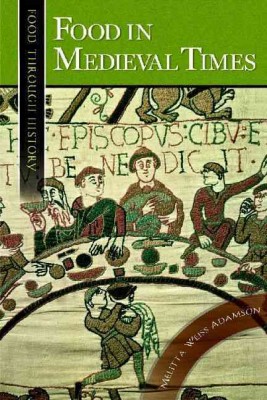| Food in Medieval Times Contributor(s): Adamson, Melitta Weiss (Author) |
|
 |
ISBN: 0313321477 ISBN-13: 9780313321474 Publisher: Greenwood OUR PRICE: $66.33 Product Type: Hardcover - Other Formats Published: October 2004 Annotation: New light is shed on everyday life in the Middle Ages in Great Britain and continental Europe through this unique survey of its food culture. Students and other readers will learn about the common foodstuffs available, how and what they cooked, ate, and drank, what the regional cuisines were like, how the different classes entertained and celebrated, and what restrictions they followed for health and faith reasons. Fascinating information is provided, such as on imitation food, kitchen humor, and medical ideas. Many period recipes and quotations flesh out the narrative. The book draws on a variety of period sources, including as literature, account books, cookbooks, religious texts, archaeology, and art. Food was a status symbol then, and sumptuary laws defined what a person of a certain class could eat--the ingredients and preparation of a dish and how it was eaten depended on a person's status, and most information is available on the upper crust rather than the masses. Equalizing factors might have been religious strictures and such diseases as the bubonic plague, all of which are detailed here. |
| Additional Information |
| BISAC Categories: - Cooking | History - History | Europe - Medieval - History | Social History |
| Dewey: 641.300 |
| LCCN: 2004014054 |
| Series: Food Through History |
| Physical Information: 1.03" H x 6.34" W x 9.58" (1.31 lbs) 288 pages |
| Themes: - Chronological Period - Medieval (500-1453) |
| Descriptions, Reviews, Etc. |
| Publisher Description: Students and other readers will learn about the common foodstuffs available, how and what they cooked, ate, and drank, what the regional cuisines were like, how the different classes entertained and celebrated, and what restrictions they followed for health and faith reasons. Fascinating information is provided, such as on imitation food, kitchen humor, and medical ideas. Many period recipes and quotations flesh out the narrative. The book draws on a variety of period sources, including as literature, account books, cookbooks, religious texts, archaeology, and art. Food was a status symbol then, and sumptuary laws defined what a person of a certain class could eat--the ingredients and preparation of a dish and how it was eaten depended on a person's status, and most information is available on the upper crust rather than the masses. Equalizing factors might have been religious strictures and such diseases as the bubonic plague, all of which are detailed here. |